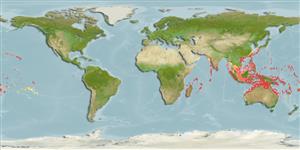Common names from other countries
Environment: milieu / climate zone / depth range / distribution range
Écologie
marin récifal; profondeur 1 - 60 m (Ref. 27115), usually 25 - 60 m (Ref. 27115). Tropical; 24°C - 28°C (Ref. 27115); 35°N - 31°S, 30°E - 128°W
Indo-Pacific: East Africa, including the Mascarene Islands (Ref. 37792) to the Hawaiian, Marquesan, and Tuamoto islands, north to southern Japan, south to Lord Howe Island.
Taille / Poids / Âge
Maturity: Lm ? range ? - ? cm
Max length : 100.0 cm TL mâle / non sexé; (Ref. 2334)
Épines dorsales (Total) : 5; Rayons mous dorsaux (Total) : 28 - 29; Épines anales: 2; Rayons mous anaux: 27 - 28. Plain brown or olivaceous in color, paler below; subadults with black caudal rays, narrow margins and white caudal filaments; pectoral fins with white distal margins (Ref. 3145).
Juveniles occur in clear, shallow lagoon reefs at depths as little as 1 m; adults rarely seen in less than 25 m, encountered off outer reef drop-offs in small schools (Ref. 30573, 48637). Benthopelagic (Ref. 58302). Feeds on large zooplankton during the day and shelter within the reef during the night; also benthic algae (Ref. 30573, 48637).
Life cycle and mating behavior
Maturities | Reproduction | Spawnings | Egg(s) | Fecundities | Larves
Spawn in pairs (Ref. 240).
Myers, R.F., 1991. Micronesian reef fishes. Second Ed. Coral Graphics, Barrigada, Guam. 298 p. (Ref. 1602)
Statut dans la liste rouge de l'IUCN (Ref. 130435)
CITES (Ref. 128078)
Not Evaluated
Menace pour l'homme
Reports of ciguatera poisoning (Ref. 30298)
Utilisations par l'homme
Pêcheries: commercial; Aquarium: Commercial
Outils
Articles particuliers
Télécharger en XML
Sources Internet
Estimates based on models
Preferred temperature (Ref.
115969): 23.5 - 28.3, mean 27.1 (based on 335 cells).
Phylogenetic diversity index (Ref.
82804): PD
50 = 0.5000 [Uniqueness, from 0.5 = low to 2.0 = high].
Bayesian length-weight: a=0.02239 (0.01279 - 0.03918), b=2.97 (2.82 - 3.12), in cm Total Length, based on LWR estimates for this species & Genus-body shape (Ref.
93245).
Niveau trophique (Ref.
69278): 2.1 ±0.09 se; based on food items.
Résilience (Ref.
120179): Faible, temps minimum de doublement de population : 4,5 à 14 années (K=0.213; Tmax=23).
Fishing Vulnerability (Ref.
59153): Moderate to high vulnerability (45 of 100).
